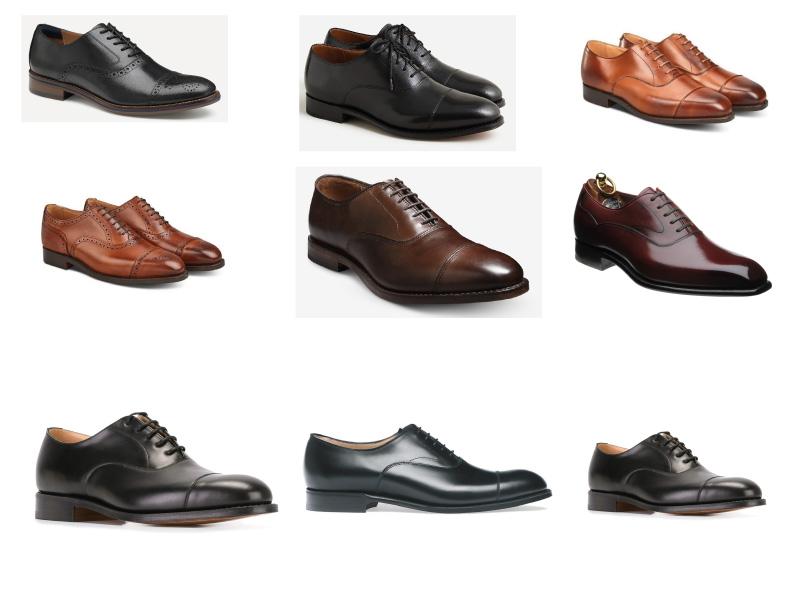
Imagine a shoe that effortlessly blends timeless elegance with modern sophistication.
A shoe that has graced the feet of style icons, businessmen, and trendsetters alike.
A shoe that transcends mere footwear and becomes a symbol of refined taste and sartorial excellence.
Welcome to the world of Oxford shoes – a realm where classic design meets impeccable craftsmanship, creating a lasting statement of style.
From the hallowed halls of Oxford University to the red carpets of today, these iconic lace-up dress shoes have captured the hearts and soles of discerning gentlemen worldwide.
With their sleek lines, superior construction, and undeniable versatility, Oxford shoes are more than just a fashion statement; they are a testament to the enduring appeal of timeless elegance.
Prepare to embark on a journey through the rich history, intricate design, and exquisite craftsmanship that make Oxford shoes a true masterpiece of footwear.
Discover the secrets to identifying genuine Oxford shoes, explore the world's finest brands, and unlock the art of caring for these treasured possessions.
Whether you're a seasoned sartorialist or a newcomer to the realm of refined footwear, this comprehensive guide will equip you with the knowledge to elevate your style and embrace the enduring allure of Oxford shoes.
Introduction
Oxford shoes are a timeless and iconic style of dress shoes that have been a staple in men's fashion for centuries.
These sophisticated shoes are known for their clean and elegant lines, making them a versatile choice for both formal and casual occasions.
Whether you're dressing up for a wedding, a business meeting, or a night out, Oxford shoes can add a touch of sophistication and refinement to any ensemble.
In this comprehensive guide, we'll delve into everything you need to know about Oxford shoes, from their origins to how to spot fake ones.
What are Oxford Shoes?
Oxford shoes are a type of dress shoe characterized by their closed lacing system, where the shoelace eyelets are attached to the vamp (the front part of the shoe that covers the foot).
This gives Oxfords a clean and streamlined appearance, making them suitable for various occasions, from business meetings to weddings.
This design creates a clean and streamlined look, distinguishing Oxford shoes from other dress shoe styles like Derby shoes or monk straps.
Oxford shoes typically feature a low heel and are made from leather or suede, although modern variations may incorporate different materials for aesthetic or functional purposes.
What is the Origin of the Name?
The name "Oxford" is derived from the prestigious Oxford University in England, where this style of shoe allegedly originated.
In the 1800s, students at Oxford began wearing a particular style of low-cut shoes with closed lacing, which became known as Oxonians.
Over time, the term "Oxford" was adopted to refer to this style of footwear and the style became closely associated with the university.
Why are They Called Oxfords?
The term "Oxford" is not just a name but also a descriptor of the specific construction and design of these shoes.
The closed lacing system, where the quarters (the sides of the shoe) are sewn on top of the vamp, creating a smooth and sleek appearance, is what defines an Oxford shoe.
This construction method sets Oxford shoes apart from other dress shoe styles and gives them their distinct look.
What is the Historical Background of Oxford Shoes?
Oxford shoes have a rich history that dates back to the late 17th century.
Originally designed as a practical and durable shoe for outdoor activities, Oxford shoes gained popularity among the upper classes and soon became a symbol of sophistication and refinement.
During the Victorian era, Oxford shoes became a staple in men's fashion, and their popularity continued to grow throughout the 20th century.
By the early 20th century, Oxfords had become a symbol of sophistication and refinement, favored by both men and women.
Today, Oxford shoes are widely regarded as a classic and timeless choice for formal and business attire, as well as for dressy casual occasions.
How Do I Identify Oxford Shoes?
Identifying Oxford shoes is relatively straightforward. Look for the closed lacing system, where the shoelace eyelets are sewn under the vamp.
Additionally, Oxfords typically have a sleek silhouette with a low heel and are made from high-quality leather or suede.
The key characteristics to look for are:
Closed lacing system
The shoelace eyelets are attached to the vamp, creating a sleek and smooth appearance.
Low heel
Oxford shoes typically have a low heel, usually between 1 and 1.5 inches in height.
Leather construction
Oxford shoes are traditionally made from high-quality leather, such as calfskin or full-grain leather.
Minimal ornamentation
Oxford shoes are known for their clean and simple design, with minimal decorative elements.
What are the Different Types of Oxford Shoes?
While Oxford shoes share a common construction and design, there are several variations and subcategories within this style:
1. Wholecut Oxfords
Wholecut Oxfords are a specific style of men's dress shoes that are characterized by their sleek, seamless one-piece leather upper construction.
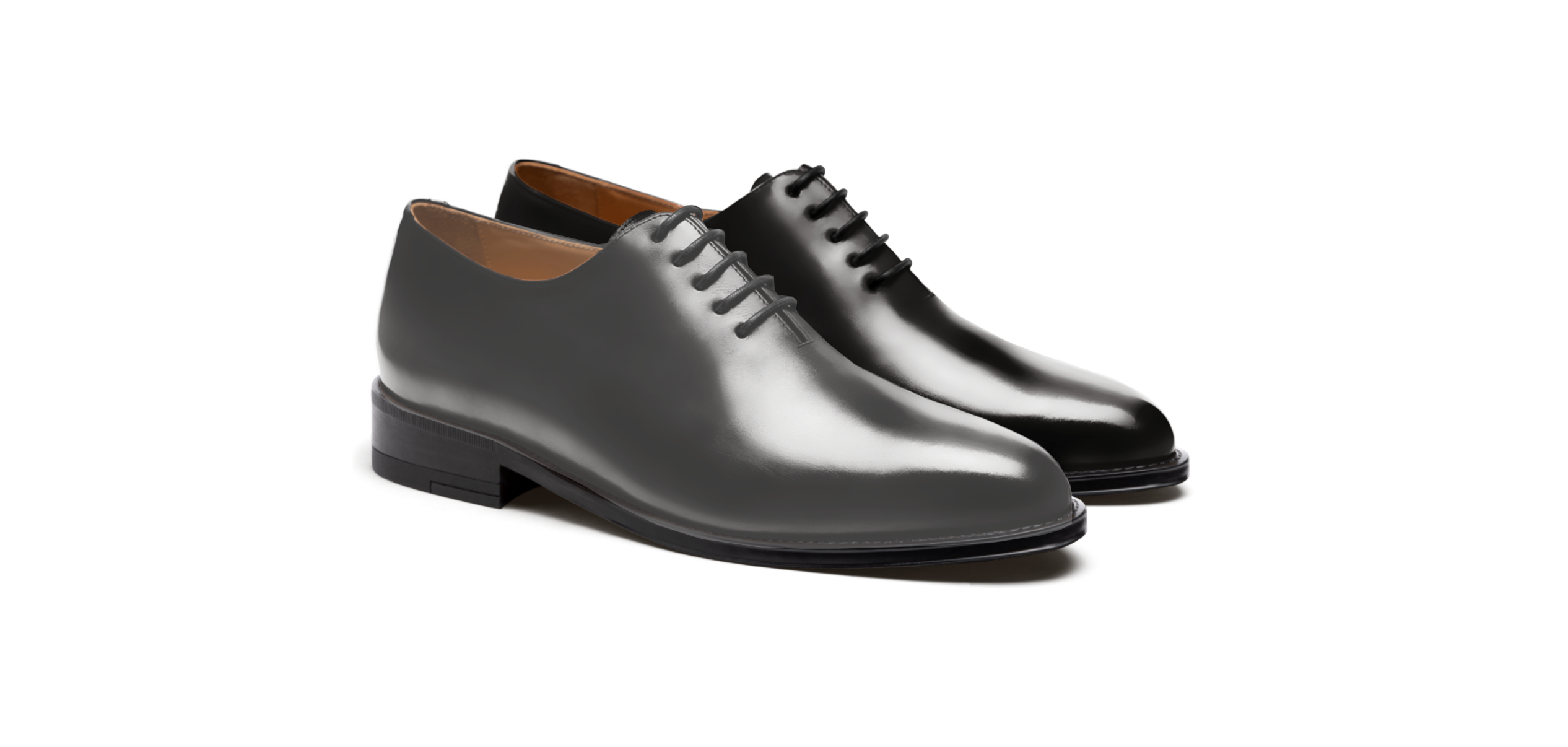
Here are some key details about Wholecut Oxfords:
- The upper part of the shoe (the part covering the foot) is made from a single piece of leather, without any seams or pieces stitched together. This gives the shoes a very clean, minimal look.
- They have a closed-lacing system, with the eyelets/lacing section stitched underneath the single leather piece, rather than having exposed tongues.
- Wholecuts are considered extremely formal and elegant dress shoes, often ranked among the most formal after opera pumps/patent leather oxfords.
- Making a true wholecut requires great leather working skill, as the single leather piece must be precision-shaped and lasted over the shoe last.
- They tend to be plainer in style with minimal brogueing or decorative punching compared to other Oxford variations.
- Wholecut Oxfords are an iconic part of formal business attire and are seen as the ultimate in understated luxury footwear when made from premium leathers.
So in summary, their seamless one-piece upper construction and formal, minimalist aesthetic are the distinguishing characteristics of high-end Wholecut Oxford dress shoes.
2. Cap-toe Oxfords
Cap-toe Oxfords are a stylish variation of the classic Oxford dress shoe that features a distinct cap-toe design.
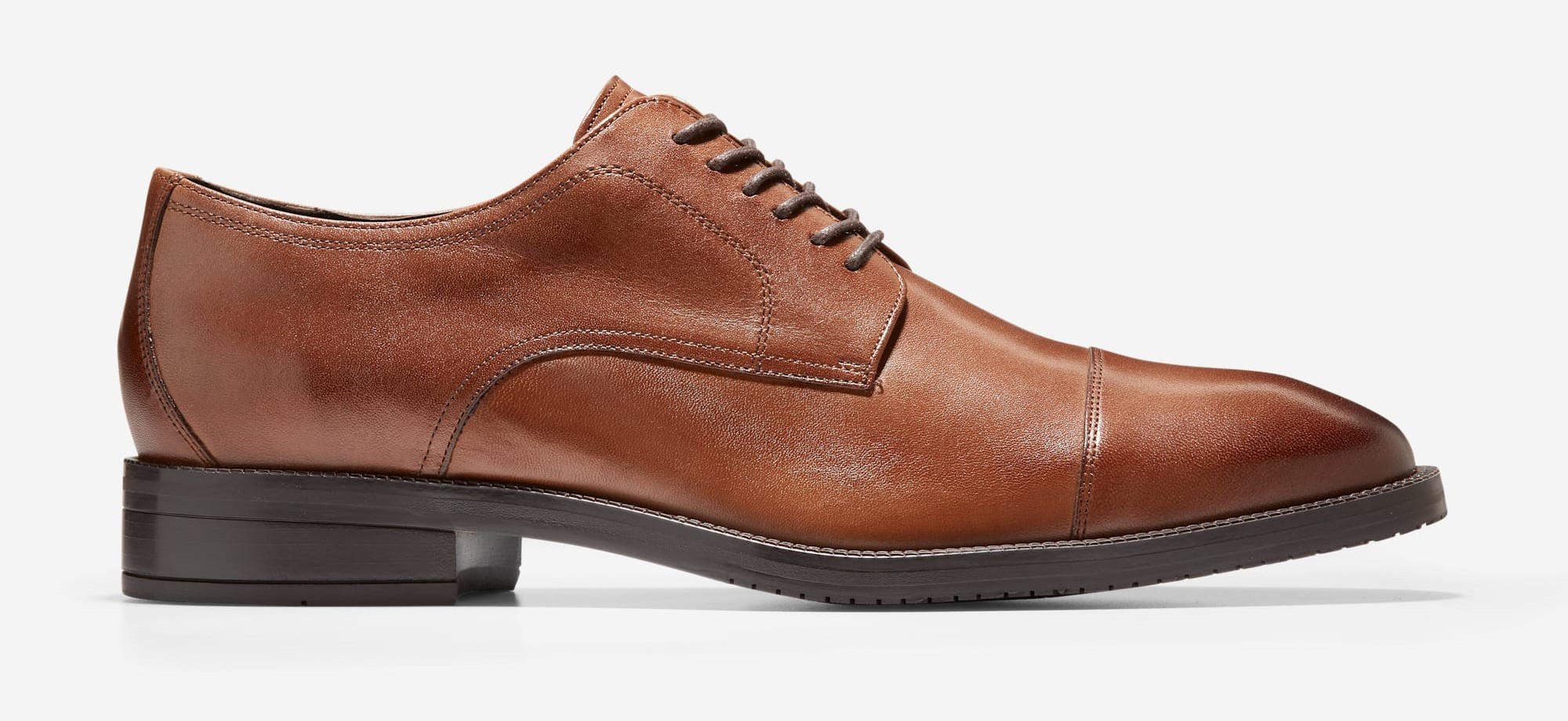
The key characteristics of cap-toe Oxfords are:
- Cap Toe: The forefoot of the shoe has an additional layer or "cap" of leather that creates a horizontal line across the toe box. This cap-toe is stitched along the line where it meets the leather vamp.
- Closed Lacing: Like other Oxfords, they have a closed lacing system where the tongue is sewn under the front part of the quarters (the leather panels forming the sides of the shoe).
- Formal Style: Cap-toes are considered a dressier style of Oxfords suitable for business professional and formal occasions.
- Toe Shape: The toe box can vary from almond/round to slightly squared/chisel shapes.
- Construction: They can be made with various construction methods like Goodyear welting or Blake stitching.
The cap-toe design elongates the appearance of the foot and adds an elegant visual detail compared to plain toe Oxfords. It is a popular style that strikes a balance between formal and stylish.
Some high-end shoemakers are known for their exquisite cap-toe Oxford models made from premium leather selections and expert craftsmanship.
3. Wingtip Oxfords
Wingtip Oxfords, also known as full brogues or wingtips, are a distinctive style of dress shoes that feature elaborate perforated decorative patterns on the toe cap and along the sides of the shoes.
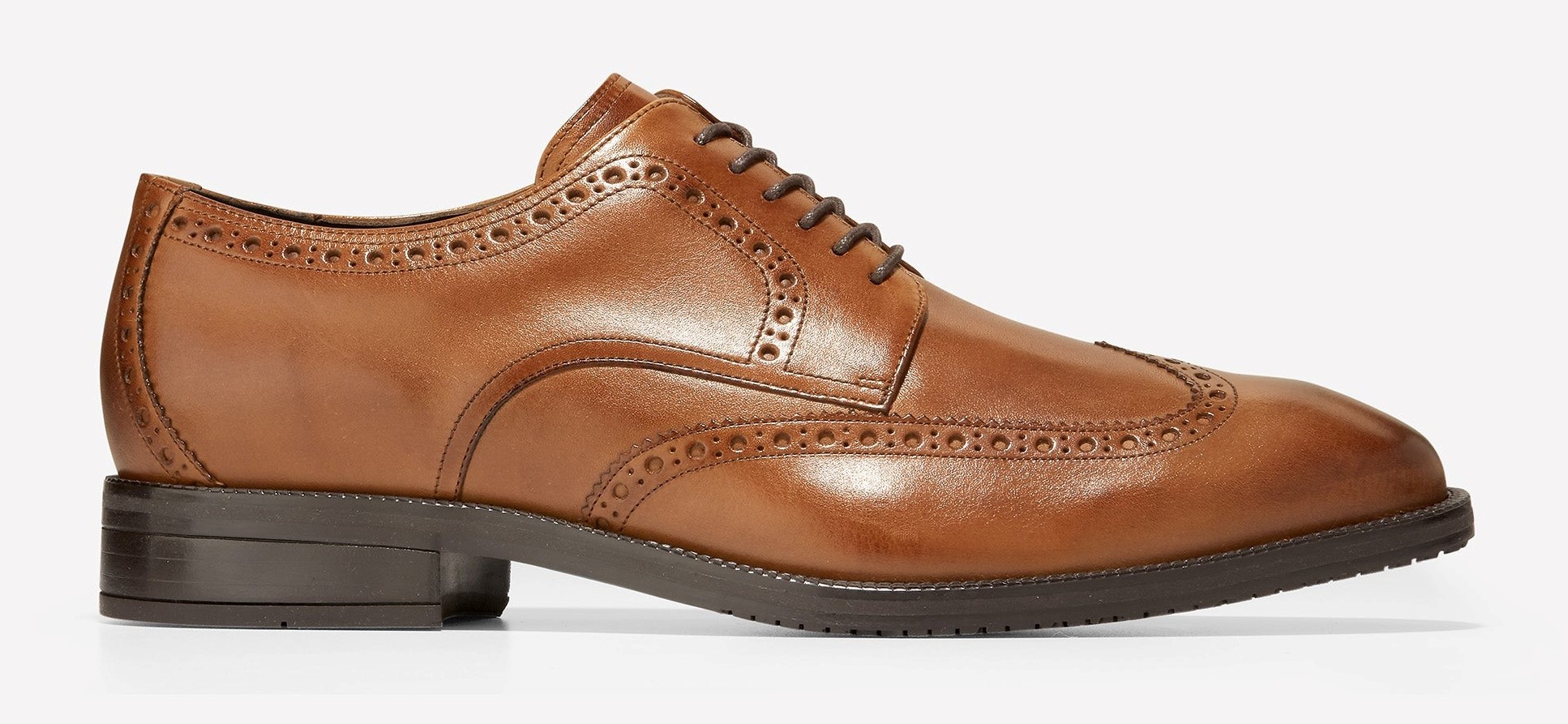
The key features of Wingtip Oxfords are:
- Wingtip Toe Cap: They have a toe cap that extends into "wings" along the sides of the shoes, creating a W-shaped cap outline. This wingtip cap has perforated brogue details.
- Quarters Broguing: In addition to the wingtip toe, the leather quarters (sides) of the shoes also have perforated brogue patterns.
- Lace-Up Style: Like other Oxfords, Wingtips have a closed lacing system with the tongue underneath.
- Leather Uppers: They are typically made from sturdy calfskin or scotch grain leathers.
- Toe Shape: The toe box can range from round/almond to slightly squared toe shapes.
While still formal dress shoes, Wingtip Oxfords are considered slightly less formal than plain cap-toe or wholecut Oxfords due to their heavier broguing details. However, they add a touch of distinctive style.
Wingtips were originally outdoor shoes but became incorporated into business/semi-formal dress codes. Quality wingtip Oxfords can be very expensive when made by high-end shoemakers.
4. Split-toe Oxfords
Split-toe Oxfords, also known as split-toes or Norweger, are a distinctive style of dress shoes characterized by their split toe box design.
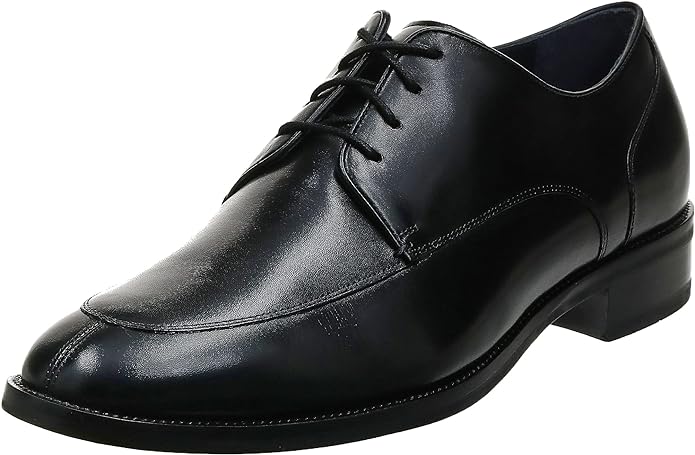
The key features of split-toe Oxfords are:
- Split Toe Box: Instead of a single toe box, the forefoot section is separated into two symmetrical pieces of leather with a straight vertical seam running down the middle of the toe.
- V-shaped Seam: When viewed from above, the split toe forms a V-shaped seam at the front.
- Closed Lacing: Like other Oxfords, they have a closed lacing system with the tongue underneath.
- Oxford Pattern: Other than the split toe, the shoes follow the classic Oxford pattern with a lower section (the vamp) sewn onto the one-piece quarters.
- Dressy Style: Split-toes are considered a very stylish and slightly dressier variation of the basic Oxford.
The split-toe design creates an elongated, sleek toe box shape. It originated in Norway, hence the "Norweger" name, but became stylish worldwide.
While not as formal as wholecut Oxfords, quality split-toes made from fine leathers are still appropriate for business professional and semi-formal occasions when you want a distinctive, fashionable dress shoe.
5. Longwing Oxfords
Longwing Oxfords, also known as Gunboats or Wingtips, are a variation of the classic Wingtip Oxford dress shoes with an elongated wing-tip design.
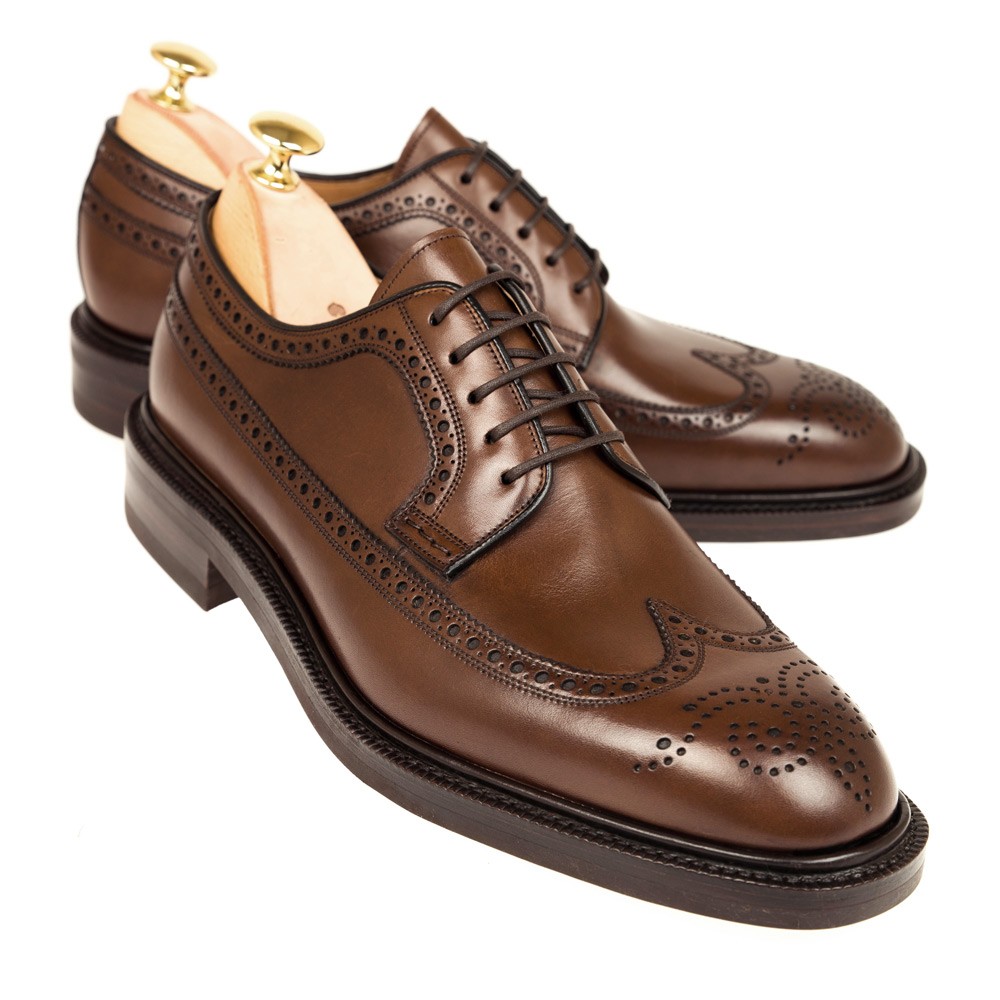
The key features of Longwing Oxfords are:
- Extended Wingtip Design: The wingtip toe cap extends way down along the sides of the shoe in long "wings" or "gunboats" that run parallel to the sole.
- Brogue Detailing: Like regular Wingtips, Longwings feature decorative perforated brogue patterns on the toe cap and along the extended wings.
- Closed Lacing: They have a closed lacing system with the tongue tucked underneath.
- Leather Uppers: Sturdy calfskin or scotch grain leathers are commonly used.
- Toe Shape: The toe box is rounded or slightly squared off.
The extended wingtip design gives Longwings a very distinctive, statement-making look compared to regular Wingtips. They are considered a more casual, stylistic variation not suited for extremely formal settings.
Longwings originated in the early 20th century and were popular among polo players, hunters and the military, giving them their "Gunboat" nickname. Today, they remain a fashionable semi-dressy shoe option.
While elaborate, quality longwing construction requires great shoemaking skill due to the intricate wingtip patterns and shaping involved.
How to Take Care of Your Oxford Shoes
Proper care and maintenance are essential for preserving the quality and longevity of your Oxford shoes.
Here are some tips to keep them looking their best:
Rotate your shoes
Alternate between different pairs of Oxford shoes to allow them to dry and rest properly between wears.
Use cedar shoe trees
Insert cedar shoe trees into your Oxford shoes when not wearing them to help maintain their shape and absorb moisture.
Clean and polish regularly
Use a high-quality leather cleaner and conditioner to remove dirt and stains, and apply a polish to maintain the leather's shine and protection.
Protect from water and salt
Avoid wearing Oxford shoes in wet or salty conditions, as moisture can damage the leather. Consider using a water-resistant spray for added protection.
Have them resoled and recrafted
When the soles wear down, have your Oxford shoes resoled by a professional cobbler to extend their lifespan.
What is the Anatomy of Oxford Shoes?
Understanding the different parts of Oxford shoes can help you better appreciate their construction and design.
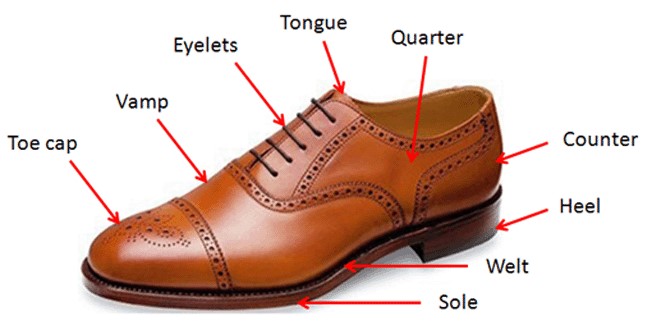
Here are the key components:
1. Toe cap
The toe cap of an Oxford shoe refers to the additional layer of leather or other material that covers the toe area of the shoe. This layer serves both functional and aesthetic purposes.
Functionally, it reinforces the front part of the shoe, providing extra durability and protection to the toes.
Aesthetically, it adds a distinctive visual element to the shoe, giving it a more formal and structured appearance.
Toe caps can come in various styles, including plain, punched (brogue), or decorated with medallions or other patterns, depending on the design of the shoe.
2. Vamp
The vamp of an Oxford shoe is the upper part of the shoe that covers the top of the foot from the toe box to the throat (the part where the laces are). It essentially constitutes the front part of the shoe's upper.
The vamp plays a crucial role in determining the overall fit and appearance of the shoe. It can vary in style and design, featuring different materials, stitching patterns, and decorative elements depending on the specific type of Oxford shoe..
3. Eyelets
The eyelets of an Oxford shoe are the small holes or metal rings through which the shoelaces are threaded.
These eyelets are typically positioned along either side of the shoe's vamp, allowing the laces to be tightened or loosened to adjust the fit of the shoe.
The number and spacing of the eyelets can vary depending on the style of the Oxford shoe. For example, some Oxfords may have three pairs of eyelets, while others may have five or more pairs.
The eyelets serve a functional purpose by securely fastening the shoe and also contribute to its aesthetic appeal, as they are often visible elements of the shoe's design.
4. Tongue
The tongue of an Oxford shoe is a strip of material, usually made of leather or synthetic material, that lies under the laces and covers the instep of the foot when the shoe is laced up.
It extends from the toe box to the throat of the shoe. The primary function of the tongue is to provide a barrier between the foot and the laces, preventing discomfort or irritation caused by the laces pressing against the foot.
Additionally, the tongue helps to distribute the pressure from the laces evenly across the instep when the shoe is tightened.
In terms of design, the tongue may be padded or unpadded, depending on the style and construction of the shoe, and it may feature stitching or other decorative elements for aesthetic purposes.
5. Quarter
In shoemaking, the quarter of an Oxford shoe refers to the rear part of the shoe's upper that covers the heel and extends forward to meet the vamp at the throat line.
The quarters typically wrap around the sides and back of the foot, providing structural support and contributing to the overall fit of the shoe.
In Oxfords, the quarters are usually stitched to the vamp, forming a seamless transition between the two sections of the upper.
The design and construction of the quarters can vary depending on the specific style of the Oxford shoe, with options ranging from plain and simple to more elaborate and decorative designs.
6. Heel counter
The heel counter of an Oxford shoe is a stiff piece of material, often made of leather or a synthetic material, that is inserted between the lining and the upper material at the back of the shoe.
It is located around the heel area and serves to reinforce the structure of the shoe, providing stability and support to the wearer's heel.
The heel counter helps to maintain the shape of the shoe and prevents it from collapsing inward, especially during movement.
Additionally, it assists in keeping the foot securely in place within the shoe, minimizing slippage and improving overall comfort and fit.
The height and rigidity of the heel counter can vary depending on the specific design and intended use of the Oxford shoe.
7. Welt
The welt of an Oxford shoe is a strip of material, typically leather, that is stitched around the perimeter of the outsole, attaching it to the upper of the shoe.
It serves as a means of both attaching the outsole to the upper and providing additional strength and durability to the shoe's construction.
There are different types of welts used in shoemaking, including Goodyear welt, Blake stitch welt, and cemented welt.
The choice of welt construction can affect factors such as the flexibility, water-resistance, and ease of repair of the shoe.
In Oxfords, a welt is typically present along the entire perimeter of the outsole, contributing to the shoe's overall quality, longevity, and appearance.
8. Outsole
The outsole of an Oxford shoe is the bottom-most layer of the shoe that comes into direct contact with the ground. It is typically made of a durable material such as rubber, leather, or synthetic compounds.
The outsole plays a crucial role in providing traction, stability, and protection to the wearer's feet, especially against rough or slippery surfaces.
The design of the outsole can vary depending on the specific style and intended use of the Oxford shoe.
For example, dress Oxfords often feature sleek and thin outsoles for a more formal appearance, while casual or outdoor Oxfords may have thicker and more rugged outsoles for enhanced durability and grip.
In addition to its functional aspects, the outsole also contributes to the overall aesthetic of the shoe, and it may be embellished with patterns, textures, or branding elements to enhance its visual appeal.
9. Insole
The insole of an Oxford shoe is the innermost layer of the shoe that comes into direct contact with the bottom of the foot. It is typically a removable or non-removable cushioned layer that provides comfort and support to the wearer.
The primary functions of the insole include:
- Cushioning: The insole absorbs shock and impact while walking, running, or standing, helping to reduce fatigue and discomfort.
- Support: It provides arch support and helps distribute the body weight evenly across the foot, promoting proper alignment and reducing strain on the feet and lower limbs.
- Moisture absorption: Some insoles are designed to wick away moisture and keep the feet dry and comfortable, especially in hot or humid conditions.
- Insulation: In colder climates, insoles may provide insulation to help keep the feet warm.
Insoles can be made from various materials such as foam, gel, leather, or cork, and they may come in different thicknesses and levels of firmness to accommodate various foot shapes and preferences.
Additionally, some Oxford shoes may feature removable insoles that can be replaced with custom orthotics for individuals with specific foot conditions or preferences.
What are the Best Oxford Shoes Brands?
While there are numerous brands that produce Oxford shoes, some have built a reputation for exceptional quality and craftsmanship.
Here are some of the best Oxford shoe brands:
Allen Edmonds
An American brand known for its high-quality, handcrafted Oxford shoes made from premium leathers.
Crockett & Jones
A British brand with a rich heritage, known for its impeccable craftsmanship and attention to detail.
Edward Green
A renowned British shoemaker that has been producing exceptional Oxford shoes since 1890.
Carmina Shoemaker
A Spanish brand that offers a wide range of high-quality, handmade Oxford shoes.
Church's
A British brand with a long history, known for its classic and timeless Oxford shoe designs.
Alden
Handcrafted in the USA, Alden shoes are prized for their durability and comfort.
You may want reading this review : Top 21 Oxford Shoes Brands in the world
What are the Most Popular Oxford Shoes?
While Oxford shoes come in various styles and designs, some models have become iconic and highly sought after.
Here are some of the most popular Oxford shoes:
Allen Edmonds Park Avenue
A classic cap-toe Oxford shoe known for its versatility and timeless style.
Crockett & Jones Hallam
A beautifully crafted wholecut Oxford shoe that epitomizes elegance and sophistication.
Edward Green Piccadilly
A timeless and refined Oxford shoe with a sleek and streamlined design.
Carmina Shoemaker Semi Brogue Oxford
A stylish and versatile Oxford shoe with decorative broguing details.
Church's Consul
A sleek and minimalist Oxford shoe that showcases the brand's exceptional craftsmanship.
Church's Shannon Derby
Exemplifying British craftsmanship, these Oxfords are synonymous with luxury and sophistication.
Alden 9901 Cordovan Cap Toe
Crafted from premium shell cordovan leather, these Oxfords are coveted for their durability and rich patina.
How to Check if the Oxford Shoes are Genuine or Fake
Given the popularity and demand for high-quality Oxford shoes, counterfeit products have become a concern in the market.
Here are some tips to help you identify genuine Oxford shoes:
Examine the construction
Look for signs of quality craftsmanship, such as even stitching, smooth leather, and precise detailing.
Check the branding
Ensure that the branding, logos, and markings are consistent with the brand's authentic products.
Inspect the sole
Genuine Oxford shoes often have high-quality, durable soles with distinct patterns or markings.
Look for imperfections
While handmade shoes may have minor imperfections, significant flaws or inconsistencies can be a sign of a counterfeit product.
Purchase from authorized retailers
Buy from reputable retailers or directly from the brand's website to ensure authenticity.
Where Do Fake Oxford Shoes Come From?
Counterfeit Oxford shoes can originate from various sources, but they are often produced in countries with lax intellectual property laws and poor manufacturing regulations.
Some of the regions known for producing fake Oxford shoes include:
- China
- India
- Thailand
- Turkey
- Vietnam
These counterfeit products are often sold through unauthorized online retailers or street markets, taking advantage of unsuspecting buyers.
How to Avoid Buying Fake Oxford Shoes
To protect yourself from purchasing counterfeit Oxford shoes, it's essential to be vigilant and take the following precautions:
Research and educate yourself
Learn about the brand's authentic products, their construction, and identifying features.
Buy from authorized retailers
Purchase Oxford shoes from the brand's official website, authorized retailers, or reputable department stores.
Inspect the shoes carefully
Thoroughly examine the shoes for any signs of poor quality or inconsistencies with the brand's genuine products.
Be wary of heavily discounted prices
If the price seems too good to be true, it could be a red flag for a counterfeit product.
Seek expert advice
If you're unsure about the authenticity of a pair of Oxford shoes, consult with a professional or reach out to the brand directly for assistance.
Final Thoughts
Oxford shoes are a timeless and elegant choice for men's footwear, combining style and sophistication with versatility and comfort.
Whether you're dressing for a formal occasion or a casual outing, a well-crafted pair of Oxford shoes can elevate your look and add a touch of refinement to your ensemble.
By understanding the history, construction, and various styles of Oxford shoes, you can make an informed decision when investing in a high-quality pair.
Remember to prioritize quality, authenticity, and proper care to ensure that your Oxford shoes remain a lasting and stylish addition to your wardrobe.
